The Grenada Revolution in the Caribbean Present
by Sheyla Hirshon
 HAVANA TIMES — For some of us, the mention of the Caribbean island country of Grenada brings a vague visceral feeling of discomfort, like a tragic accident in the family never again discussed.
HAVANA TIMES — For some of us, the mention of the Caribbean island country of Grenada brings a vague visceral feeling of discomfort, like a tragic accident in the family never again discussed.
Scattered images return to us: the “New Jewel Movement”, whose name says everything about the promise of it; Maurice Bishop leading the first popular leftist revolution in the English-speaking Caribbean. Then, a brief four years later, the anguish of witnessing US battleships steaming towards the tiny island.
These images are accompanied, perhaps, by the nagging feeling that “something else happened”, something even more disturbing than the widely broadcast images of US soldiers being overwhelmingly welcomed by the native population.
Perhaps we remember and perhaps we don’t that the US invasion was preceded by a split in the revolutionary party and a brief but traumatic struggle in which the popular Grenada leader Maurice Bishop, along with seven of his followers, were killed by their former comrades. Less than a month later, the “victorious” US forces returned home, and for all intents and purposes the world closed the curtain on the Grenadian drama.
Shalini Puri’s book brings us back to this landscape, these events, not to explain them away, justify them, or pack them into a neat academic study, but to examine the “unsettled truths and restless memories” they have left, 32 years later. She also asks the more pressing question: How do these events haunt the Caribbean in the present?
Her method and vision are best summed up by the scene that comprises the book’s front cover:
“In the north of the island is the old airfield at Pearls, which the Revolution sought to replace with the new airport at Point Salines. On its crumbling runway sit two planes, one Aeroflot and one Cubana. They have remained there for 30 years… Left there as debris… resistant to interpretation as a “message, their persistent presence is a powerful provocation. To see them is to confront the stubborn residue of history.” (p. 17)
The Grenada Revolution in the Caribbean Present leads us on a journey through Grenada’s physical, historical, social and cultural landscape in search of exactly such stubborn residue.
Also See: Cuba in the Grenada Revolution
Using elements of the landscape -“Wave”, “Fault-line”, Continent”, Stone”, “Archipelago” – as metaphors and chapter themes, Puri returns us again and again to the events of the “Revo” and its violent unraveling, each time seeing them under a different light.
The book dazzles, provokes, turns us around, and at nearly every turn brings us up against some new angle on the events of 1979 – 1983, and far far beyond.
Recapping the events
Puri is clear that her intent goes beyond assembling and recounting the facts. Nonetheless, the initial chapters do reacquaint us fully with the island’s immediate history.
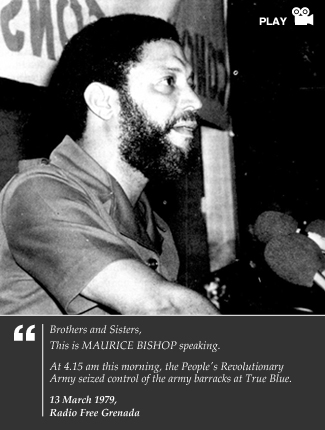 We learn of Eric Gairy’s gradual transformation from a champion of the underclass in the fifties to a harsh and corrupt messianic dictator in the 70s; the rise of the popular New Jewel Movement under the charismatic young leader Maurice Bishop, a rise that echoed so many other popular movements of the times; the NJMs nearly bloodless capture of Gairy’s barracks followed by Bishop’s “Bright New Dawn” speech, assuring democratic freedoms, respect for personal safety and property , and full acceptance of all citizens who peacefully accept the new government.
We learn of Eric Gairy’s gradual transformation from a champion of the underclass in the fifties to a harsh and corrupt messianic dictator in the 70s; the rise of the popular New Jewel Movement under the charismatic young leader Maurice Bishop, a rise that echoed so many other popular movements of the times; the NJMs nearly bloodless capture of Gairy’s barracks followed by Bishop’s “Bright New Dawn” speech, assuring democratic freedoms, respect for personal safety and property , and full acceptance of all citizens who peacefully accept the new government.
As in similar movements, these events were followed by an outpouring of the Caribbean’s best and brightest, including many Cubans, to dedicate their youthful creativity and idealistic energy to the New Jewel project.
This project, affectionately known as “the Revo”, involved, “the radical rethinking of governance and political culture, a series of ambitious economic undertakings and far-reaching transformations in the fields of health, culture and the arts.” (p. 41)
During these short years, tiny Grenada assumed a leading role on the world stage, as the protagonist of “the first socialist-oriented revolution in the Anglophone Caribbean.” (p.5)
We witness all these things through the voices, photographs, calypsos, excerpts from plays and novels, etc. that Puri assembles as relics of the joyous memories of those years.
The chapters “Fault-lines” and “Fort” bring us back to that involuntary tightening of the stomach, as Puri chronicles the movement’s inexorable change from an open popular movement to a closed Government/Party structure.

This change, as we see it, came at a high price: “Each Leninist measure which made the party capable of taking power also increased its tendency towards hierarchical decision-making and enhanced the autonomy of the leadership, both from ordinary party members and the people.” (Brian Meeks, Caribbean Revolution and Revolutionary Theory, 1993, as cited on p.65).
Eventually, the party closed in on itself, believing “that it had nothing to learn from anyone beyond its inmost circle.” (p. 82). With this came a rising ethos of militarism; censorship, arbitrary detentions, fear of being called a “counter”; and the Party’s mistaking itself for the Revolution.
Then, the tragic unraveling: in Sept. 1983 there was a split in the leadership of the NJM followed by a Party vote to establish joint leadership.
Refusing to abide by this decision, Maurice Bishop was placed under house arrest. And finally the trauma of Oct. 19th, when a crowd of jubilant grassroots supporters freed Bishop and he led them to Fort Rupert for reasons never completely ascertained.
Here, Bishop and his followers were disarmed and then killed by members of the “People’s Revolutionary Council”, later known as the Grenada 17. Their bodies were never recovered. The Revolutionary Military Council then imposed a 24 hour “shoot on sight” curfew, further horrifying and alienating the residents of the island.
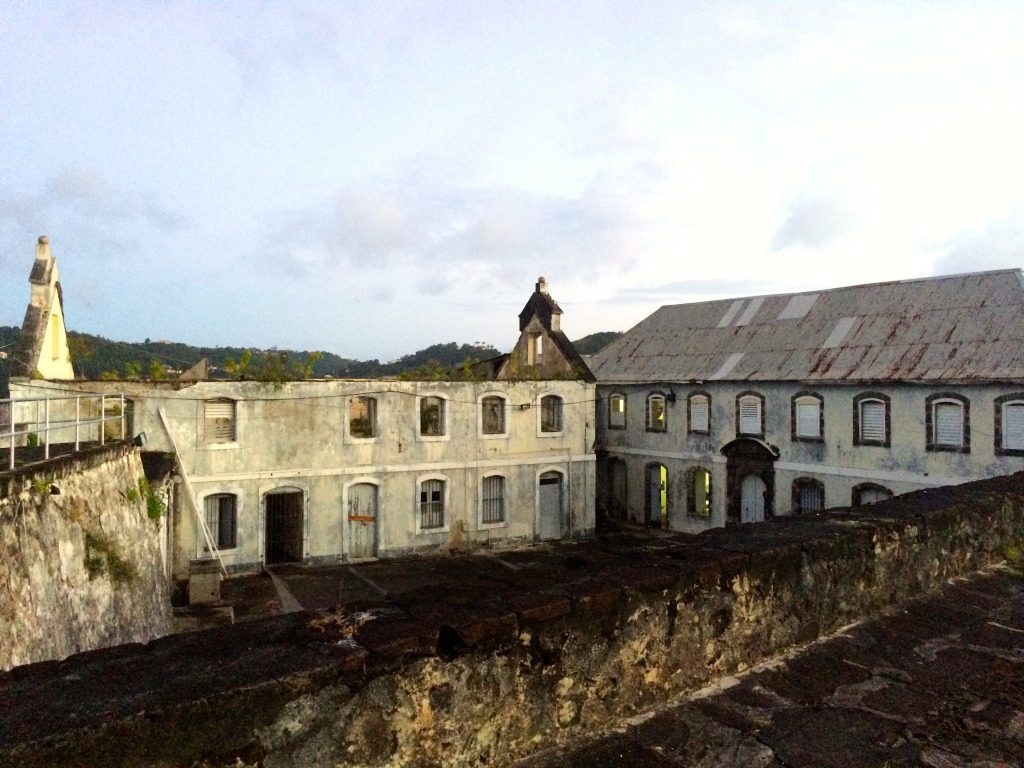
“On October 19, 1983, night fell over Grenada. Desolate.” (p.97)
In the chapter “Continent” Puri pores over the details of Ronald Reagan’s decision to launch Operation Urgent Fury, sold to the US public as an operation to rescue 750 US medical students in Grenada.
In reality, it represented “a perfect public relations opportunity: a short war, a decisive and showy victory, minimal US casualties and maximum fanfare” (p.106). The statistics offered on the invasion speak for themselves:
- Total population of Grenada in 1983 – 111,000
- US troops on active duty for “Operation Urgent Fury – 7,355 with 20,000 more stationed offshore
- US soldiers killed – 19, of which 17 were killed by accidents or friendly fire
- Cubans killed – approximately 24
- Grenadians killed in action – the United States declined to disclose the number during war, later estimates were 45 dead, 350 wounded. (statistics, p. 110).

The media were kept out and no press conferences were offered until 48 hours afterwards. The chronicled failures of this operation would be laughable if they weren’t so tragic:
The US accidentally bombed the island’s mental hospital because it was near the military target, Fort Frederick. Then, “Having rescued the medical students from the True Blue campus, the US troops began to celebrate… only to learn from the medical students that there was a second medical school campus… where the majority of medical students were. “ (p.105) These were finally rescued two days later.
The US forces mistook the bodies of 13 fallen members of the People’s Revolutionary Army soldiers for Cubans and sent their bodies to Cuba. Cuba returned them.
Although most of the US Special Forces missions ended in tragedy or failure, no one was ever fired or disciplined. Instead, some 19,600 medals were awarded for Urgent Fury.
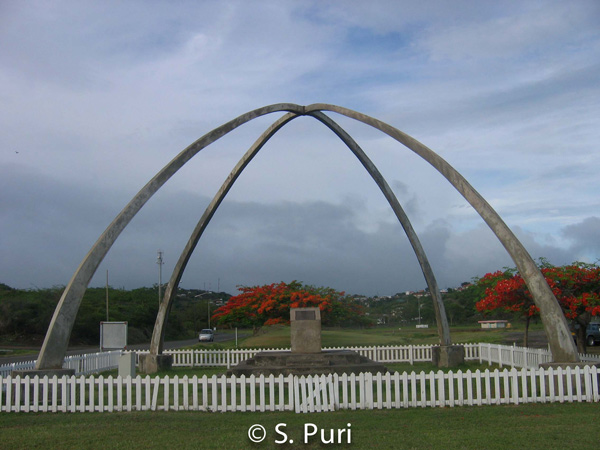
Despite this, “in the over 40 times since 1898 that the United States has intervened with direct and overt military action in the Caribbean and Latin America, rarely has it had the unambiguous support of the majority of the local population. In Grenada, it did.” (p. 99)
Confused, fearful, grief-stricken, the population saw the US invasion as deliverance from the Revolutionary Military Council which had assumed power and assassinated their popular leader.
The United States was careful to maximize their advantage when they abandoned the island, leaving behind 100 members of the Psychological Operations Unit of the US armed forces (PSYOP) to write the story of saving Grenada from Cuba and the communists in comic books, textbook and on stone monuments, beginning with the replacement of “Radio Free Grenada” with “Spice Island Radio”, which shortly after the invasion began playing the Beach Boys.
Restless memories persist
These events could be seen in many ways: as a bitter lesson for the Left, as a tragedy for those who invested the best of themselves, as a condemnation, or a challenge. However, casting judgment is clearly not the author’s intention.

“This book is not a history of the Grenada Revolution. It is a meditation on memory.” (p. 12)
In subsequent chapters, Puri addresses the many ways, choreographed and spontaneous, in which these memories pervade Grenada. She examines the monuments, erected mostly by the US to commemorate its own fallen soldiers, and the more recent renaming of the highway and airport for Maurice Bishop.
She finds other memories she terms “volcanic” – “involuntary and restive… unauthorized, unexorcised, unsanitized… latent and potentially explosive.” (p. 151)
In the voices of people interviewed, in newspapers, in calypsos, paintings, drawings, photographs, poems, narratives she moves beyond Grenada to examine the “deep regional linkages” in the Caribbean and how the Grenadian events impacted, and continue to impact the entire region.
In the later chapters we move a bit closer to the present. Puri sees the catastrophic Hurricane Ivan (2005) as a catalyst, stirring up the old, restless memories by echoing the Oct. ’83 political devastation with a purely natural disaster.
We also take a look at the prison experiences of the Grenada 17, and their eventual release in 2009. By this time, many had contributed their memoirs, and many others had renounced Marxism and turned towards religion. Moreover, the prison experience had brought them into contact and a curious solidarity with some that they themselves had imprisoned.
The Truth and Reconciliation Commission has produced its two-volume, several-hundred-page official report. Nadia Bishop, Maurice Bishop’s daughter, pronounced her unconditional forgiveness in 2008, and today “most Grenadians confront questions of ethics and forgiveness… in the register of… daily life – for example, as they decide… whether to invite someone differently positioned from themselves to a relative’s wedding.” (p. 265).
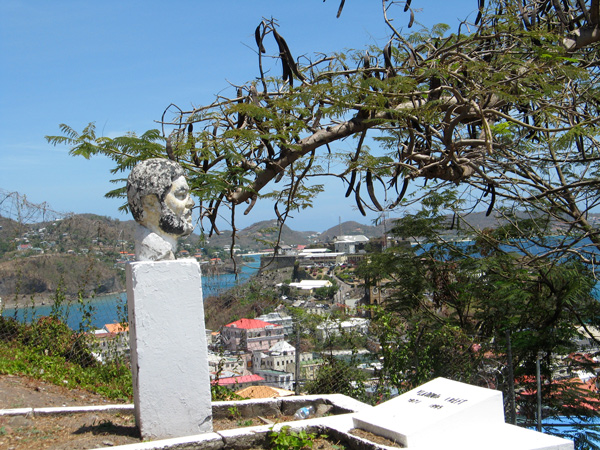
It remains to be seen whether the 50 percent of Grenadians under the age of 30, which Puri terms the “postmemory generation” will someday want to recover this history – which forms no part of their formal secondary school curriculum – and, if so, what they will make of it.
The final chapter, “Straits” brings Puri as close as she will come to a summary and a direct personal statement:
“As an outsider and a latecomer to Grenada, I grasp the burden of October 19 only partially… through imagination and analogy, through distant solidarities and close friendships. From those positions I have tried to look at the range of ways in which Grenadian and Caribbean people have remembered the Revolution and mourn. I am inspired by those who have found ways for their memory and sorrows to deliver them to action, to lead them toward Grenada rather than away from it… To both recognize one’s responsibility and not be paralyzed by it: that is one of several straits the Left has to navigate in relation to Grenada.”
Banquet of new perspectives
As a reader with little knowledge of the Caribbean but a passionate personal involvement in the general events of the period, I found this book extraordinary. It is suffused with Puri’s exhaustive knowledge of the island: music, personalities, history, art, literature, traditions, politics, and regional links.
Her writing itself finds a novel terrain where the academic meets the poetic, and she shows a rare ability to interpret the microcosm and find in it the elements that connect us all, returning us again and again to the key events, each time with new depth of understanding.
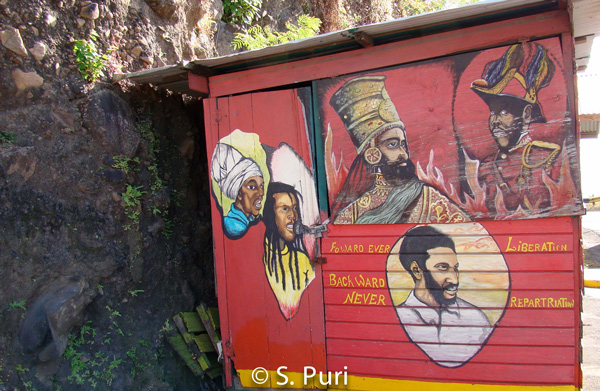
The book is rich in scholarship, but defies the traditional, neat structures of academic prose, foregoing pat conclusions in favor of asking questions, myriads of questions:
“How do people live with deep disagreements?” How do they remember, cherish and guard against the past?” (p. 24) “Given the might and antagonism of global capitalism and Rightist forces, how can the Left democratize its internal processes, civil society, and the state?”(p. 256)
There were innumerable points where I found myself pondering some new image, idea or question raised. And even as I write this review, every time I near the “send” button, some new thought or perspective floats into my mind and I feel the need to reexamine the text to be sure I have reflected it accurately.
In terms of difficulties, I missed the faces and colors of present-day Grenada, whose towns and cities we are left to imagine. Similarly, I missed the sights and voices of Grenada’s younger generations who are mentioned but never quoted.
On a lesser note, at points the detailed scrutiny of artwork and literature seems excessive and mildly frustrating, as we can see only small black and white reproductions of the visuals, we will never hear the calypsos, and the novels are not easily available outside the region.
These, however, are trifling concerns. Generally, I take my hat off to Shalini Puri for her knowledge of the island and its people, her principled concern for facts vs. truth, and her willingness to pose the hard questions.
If you are looking for a book that offers pat answers and reinforces traditional left ideas, with the usual cast of heroes and villains, this is not for you. If, however, you are still plagued, as I am, with images of joyous revolutionary movements followed by tragedy, and the question: “What did they leave behind?” this book will offer you a banquet of new perspectives to ponder.
Shalini Puri is an Associate Professor of English at the University of Pittsburgh, USA. Her previous book, “The Caribbean Postcolonial” won the 2005 Gordon and Sybil Lewis Award for Caribbean Studies. The Grenada Revolution in the Caribbean Present: Operation Urgent Memory was published in 2014 by Palgrave Macmillan, 175 Fifth Ave., New York. NY 10010. For more information visit: www.urgentmemory.com


Do different believes make people whacko is an interesting question?
I know people who are Buddhist, Jewish, Catholic, Muslim, Presbyterian, Mormon, Sikh, and politically, communist, socialist, democratic socialist, liberal, conservative, reform and in these columns a couple of anarchists. They can’t all be right, so which are whacko.
In the US there are umpteen groups with theories about conspiracies – which to many in the outside world are regarded as whacko.
Just a question about who or what merits the designation.
For someone who’s always condeming Fox News you certainly seem to watch quite a lot of it! I had to look up what you were talking about.
John, there is no need for us to watch Bill O’Reilly for examples of staggering ignorance. Your amusing posts suffice. Carry on.
Fidel only listed the Cubans he wanted to list to make his point and fool idiots who would believe him. Fidel denied that the airport had a military purpose yet there was no other reason to build such a long and fortified runway. Fidel chose points of Reagan’s speech that he understood he could refute unchallenged. Again, don’t be naive.
Fidel said there were less than 1000 Cubans in Grenada. Reagan said there were more. There is no way to prove who is telling the truth. Fidel said the airport was not for military use. Reagan said it was. Again, who knows? Fidel says the Americans were never in danger. The medical students themselves said they heard gunfire. Were they in danger? Fidel wisely picked out points he could deny and gullible folks take him at his word. I don’t.
Now I know who watches Fox News!
To an academic socialist/anarchist those who live in the real world are ignorant. To those who live in the real world we can look at the results of those who actually practice socialism and see that it just does not work. Socialism seeks the wealth that others create and then spends it and spends and spends. There remain two choices, to allow the people to have some money – as in Greece, or to keep the national debt down by impoverishing the people and allowing the infrastructure to collapse – as in Cuba. Either way, socialism in reality is a failure. I know that these comments are likely to bring yet another tirade about STATE CAPITALISM.
If Reagan was right in invading Grenada, why was it necessary for him and members of his administration to tell a total of 19 lies in attempting to justify his invasion ?
Your story about a year-long curfew so the Soviets could bring in weapons is likely bullshit.
One of the lies Reagan told was that the Cubans were storing up weapons in a particular weapons warehouse on Grenada to use in helping start revolutions in Central , South America and the Caribbean .
That claim was shown to be a lie when the warehouse was finally opened to reporters and was found to contain normal weaponry for a country of 200,000 people’s defense and police force. Some rifles were of World War One origin.
I guess you would have preferred Gairy , the previous whacko leader of Grenada who believed in flying saucers.
For me to state that the bulk of the U.S. electorate is largely illiterate and with severe historical, geographical and ignorance is just being honest.
Anyone who doubts the veracity of these claims need only ask a few close friends and relatives where Grenada or Iraq or their own state is on a map of the world.
There is an occasional segment of Bill O’Reilly’s Fox News show called “Watter’s World ” in which Mr Watters goes out in the street and actually asks this sort of basic stuff about the U.S, history and basically grammar and high school level questions of average people.
The ignorance is staggering and it is not condescending to note that fact , just very sad.
Did you read Fidel’s list of Reagans lies?
You needn’t answer because if you did , you are doing your usual willful ignoring of plain facts and not addressing any of the lies but making a blanket statement that Fidel lies.
You are so intellectually dishonest ( and ignorant) that you cannot take any one of the 13 lies and show it to be true or you would have done it.
Fidel presented a detailed list of the Cuban personnel in Grenada at the time of the U.S. invasion
It listed each Cuban’s name age and organization .
After the invasion was long over , every point made by Fidel in that speech that you obviously did not read was validated by the facts .
This sentence in your post makes no sense “Fidel also denied that his intentions included infiltrating the New Jewel movement but his fellow socialists who had supported his coup saw Castro’s intentions differently”
Fidel was best of friends with Maurice Bishop and his New Jewel Movement . The Coard coup was carried out without any Cuban involvement . Anyone who says different is just ignorant of that relationship between Bishop and Fidel .
You advise NOT reading Fidel’s speech on the lies of Reagan because it is your cowardly way to willfully ignore facts you don’t like rather than go point by point and try to prove them wrong
If you wish to persist, I will post all 13 of Reagan’s lies and show that they were lies and that you still don’t know shit from Shinola. about the Grenada invasion.
If you’d like , pick out any one of the 13 lies yourself and tell us all why it wasn’t a lie if that will make it any easier on your tiny brain.
C’mon, wolf ticket TRY to do it .
I need a good laugh today.
I am here as a Grenadian(family first got there around 1890)that was there during the coup with the Russian ship in port and had to live with a curfew from 6 pm to 6 am for a year or be shot on site ,so that they could bring in all the weapons. None of your homes had the windows shaking while they would be practicing with the anti aircraft guns at night and having 15 year old boys with AK -47 guns stopping you and searching you at will.My brother was in the PRA and was the guard to Maurice Bishop’s wife(Angela Redhead Bishop) and his best friend was in intelligence , so we knew the truth. Hopefully for the last time, I will say that Reagan was right in what he did and stop all of you NON Grenadians, including the book writers etc. from knowing better about my country.
Nothing to say but snipey remarks of no consequence again? What about the article, did you read it? What about John’s postings? He is absolutely right, you know, on both counts. Grenada exposed the USA for what it is, a bully and a sore looser who would invade and murder in a defenseless, tiny, island nation because they had been loosing ground all over the world against the rising tide of resistance to their international aggression.
On the second count and the focus of your displeasure and sensitivity, the People of the USA as a whole are famously ignorant of anything outside the USA including world geography. Most keep their eyes and attention on the tube or the screen and the “American Dream” and try to cope with their ultra busy lives in the “Matrix”, while repeating over and over the mantra “I am free” and owing their soul to the banks and the credit companies.
We even have a regular segment on USA ignorance about Canada in one of our comedy shows where a ” Canadian reporter” does live interviews with people on the street in the USA and demonstrates this very point…Zo IC, you grew up in USA schools and probably hold a high-school diploma or the equivalent; would you know which Ocean the Maldive Islands are on without looking it up? How about the town of Bluefields in the Americas? What about the capital city and continent of the North-West Territories? If you were honest with yourself you might have realized the educational shortcomings found in world geography taught in the USA, but because it’s outside of your ethnic horizon (Cuba) or where you are (USA), you don’t really care.
You are least able to correct my syntax. Beyond that however is a a simple point. Just because Fidel said that Reagan lied does not make it so. Fidel, after all, is famous for his 10 million ton harvest, super cow, and Tupac whoppers. Wait, he didn’t tell the Tupac lie, my bad.
1) There were less than 1000 and your triple negative in one sentence speaks volumes of your desire to confuse and be meaningless,
2) Your next sentence is also extremely perplexing, too many “his”
Who’s “fellow socialists”, who’s “coup”? Who were this “fellow socialists” and what exactly did they see? Again, nothing to say.
3) So tens of thousands of cops went into Cuban homes and places of work all over Havana (1983 pop. ~1,000,000) and suburbs to “force” one million Cubans to come out and hear Fidel (this is what would be needed for your non-sense version)…And what? How does this have anything to do with John’s posting except to try to deny We came then and would still come to hear Fidel from our own FREE will!
4) Your platitude about war is proof that John’s postings left you grasping at straws again and that you are saying nothing that makes any sense except John is wrong and Fidel is evil. You are all washed up in this one
Don’t be so naive. Just because Fidel denied that there were not more than a 1000 Cubans in Grenada doesn’t make it false. Fidel also denied that his intentions included infiltrating the New Jewel movement but his fellow socialists who had supported his coup saw Castro’s intentions differently. Castro spent more than 2 hours barking out his version of events to an alleged 1 million Cubans forced to gather together to hear the dictator. Your regurgitation of Castro blather should not be taken as the gospel. Hiram Johnson once said, “The first casualty, when war comes, is truth”. Advice worth taking.
Isn’t it around Newfoundland someplace. ….Don’t be so condescending, it only reflects badly on you.
An aside:
In 1963 Lyndon Johnson lied about the “Tonkin Gulf Incident” to enlarge the war on Vietnam.
In 1983 Ronald Reagan & Co. told 19 lies to justify the Grenada invasion.
In 2003 George W. Bush lied about Iraq’s nuclear weapons possession (WMDs) to justify the U.S. invasion of Iraq.
These are just a few notable incidences of the US lying to its people to lead them into imperial wars.
Now the lies are hardly necessary as the politics of fear have done their jobs and created an American populace afraid of its own shadow and clamoring for eternal war.
My guess is that a majority of people in the U.S. would be unable to find Grenada on a map or even know that it is in the Caribbean much less remember the details of the 1983 U.S. invasion.
Any doubts as to the nefarious U.S. intentions in the October invasion can be laid aside when the actual history is read.
The Reagan administration told a total of 19 lies to justify the invasion
with Reagan himself telling 13 lies in his pre-invasion speech.
I believe it was the Cuban government and specifically Fidel himself who listed the lies and I would invite anyone interested in reading the list to find it on the net
Then compare what Reagan et al said was true and what Fidel said was true for yourself.
History and time has shown -to no surprise to many of us – that the GOUSA lied and the Cuban government told the truth .
Lastly, the article said that the U.S medical students on the island were “rescued” when, in fact, they were never in danger and their safety was guaranteed by the Coard group.
There were so many lies told about 1983 Grenada that went uncontested and which still remain largely uncontested that many of those lies now carry over into what should be responsible journalism and accounts of that history.
IMO, no recounting of the Grenada invasion is worth reading without a verbatim inclusion of Fidel’s comments on the USG lies .